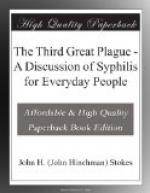+Non-hereditary Syphilis in Children.+—Syphilis in children is not always hereditary, even though the signs of it appear only a short time after birth. A woman who at the beginning of her pregnancy was free from the disease, may acquire it while she is still carrying the child as a result of her husband’s becoming infected from some outside source. The limitation which pregnancy may put on sexual indulgence leads some men to seek sexual gratification elsewhere than with their wives. The husband becoming infected, then infects his pregnant wife. There are no absolute rules about the matter, but if the mother is not infected until the seventh month of her pregnancy, the child is likely to escape the hereditary form of the disease. On the other hand, imagine the prospects for infection when the child is born through a birth-canal filled with mucous patches or with a chancre on the neck of the womb. Children infected in this way at birth do not develop the true hereditary form of the disease, but get the acquired form with a chancre and secondary period, just as in later life.
+Effect of Syphilis on the Child-bearing Woman.+—What does syphilis mean for the woman who is in the child-bearing period? In the first place, unlike gonorrhea, which is apt to make women sterile, syphilis does not materially reduce the power to conceive in most cases. A woman with active syphilis alone may conceive with great frequency, but she cannot carry her children through to normal birth. The syphilitic woman usually has a series of abortions or miscarriages, in which she loses the child at any time from the first to the seventh or eighth month. Of course, there are other causes of repeated miscarriages, but syphilis is one of the commonest, and the occurrence of several miscarriages in a woman should usually be carefully investigated. The miscarriage or abortion occurs because the unborn child is killed by the germs of the disease, and is cast out by the womb as if it were a foreign body. Usually the more active the mother’s syphilis, the sooner the child is infected and killed, and the earlier in her pregnancy will she abort. Later in the disease the child may not be infected until well along, and may die only at the ninth month or just as it is born. In other words, the rule is that the abortions are followed later by one or more still births. This is by no means invariable. The mother may abort once at the third month, and with the next pregnancy bear a living syphilitic child. The living syphilitic children are usually the results of infection in the later months of the child’s life inside its mother, or are the result of higher resistance to the disease on the part of the child or of the efficient treatment of the mother’s syphilis.




